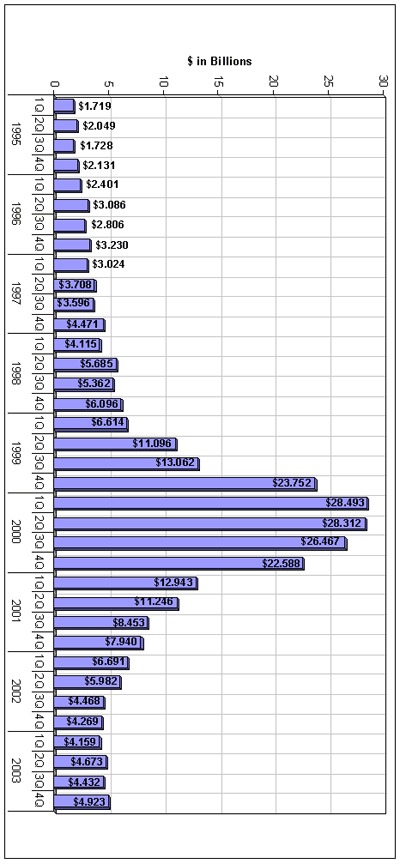Where have all the spenders gone?
February 12, 2004

Forbes magazine recently came out with its “Top 50 VCs” list, which got me thinking... Where are the VCs these days?
The data shows that venture capitalists, to a large extent, remain idle. Venture capital peaked in the first quarter of 2000, with $28.49 billion invested during that period, according to the MoneyTree Survey from PricewaterhouseCoopers, Thomson Venture Economics, and the National Venture Capital Association. Lately, it's slowed to a trickle, averaging about $4 billion per quarter during 2003.</>As indicated in the graph below, VC funding rose a bit toward the end of last year, with nearly $5 billion invested in the fourth quarter. But what's wrong with this picture? Well, for one thing, VC spending peaked precisely in conjunction with the top in the stock market, and it hasn't come back. That dashes the idea that venture capital money is "smart money" and is in any way predictive. If it were smart money, VC spending would have peaked 12 to 18 months before the Nasdaq topped – but in fact you could argue that the VCs were slow to catch on, as it kept flowing at $10 billion+ levels per quarter well after the bubble had popped.
But what's wrong with this picture? Well, for one thing, VC spending peaked precisely in conjunction with the top in the stock market, and it hasn't come back. That dashes the idea that venture capital money is "smart money" and is in any way predictive. If it were smart money, VC spending would have peaked 12 to 18 months before the Nasdaq topped – but in fact you could argue that the VCs were slow to catch on, as it kept flowing at $10 billion+ levels per quarter well after the bubble had popped.
The Nasdaq Composite has rallied 50 percent, but there's been little more than a mere burp in VC funding – it's back to mid-90s levels. And that doesn't factor in inflation and economic growth.
Now, this wouldn't be so much of a problem if the VCs were broke, or trying to feed their families. But the fact is they are sitting on piles of capital (and collecting management fees) – capital that could be used to help the economy keep rolling with entrepreneurial ideas. There are billions of dollars in uncommitted VC funds, just sitting there.
Some funds are sitting on cash hoards as high as $1 billion – and doing very little. For those of you who mailed your check into the VCs, you might have done better to invest in Treasury Bonds. For those clamoring for government stimulus (plenty of which we got), it's time to clamor for VC stimulus.
In fact, a VC looking at the VC industry with the same critical eye that he or she looks at potential investment areas might conclude that it’s unfit for investment – "Living Dead," as they say in the business.
But back to my point (and believe it or not, I actually have one). I’m not urging venture capital to go away – in fact, I’m arguing the reverse. It's time for the venture capital industry to get back to work on a greater scale.
The arguments I've heard from VCs for why they're not active just don't cut it. "We can't make money," is the first argument. That's because the climate for exit strategies is not clearly visible. That's pretty lame, considering that Juniper Networks Inc. (Nasdaq: JNPR) just bought recent IPO NetScreen Technologies Inc. (Nasdaq: NSCN) for $4 billion.
You hear that valuations were so high in 1999/2000, it's impossible to make money on deals at the current valuation level. Well, from what I see in the public markets, it's the VCs that helped drive those valuations up. VCs didn't have much trouble with valuations of 10-times sales during the peak of the bubble. So why are they so concerned about valuation now, at a time when things are actually more subdued?
Case in point: On a recent trip to Silicon Valley, I asked some venture capitalists why they hadn't invested in Google, and their answer was "valuation." At the time they were considering the investment, Google was valued at about $50 million. Pretty soon it will have an IPO that will likely value it north of $10 billion.
So we have this myth that venture capital is somehow leading markets. Right now, there's little leadership in the VC community.
The chart above establishes that VCs aren’t very good leading indicators – of anything. But what if they are good contrarian indicators? The idea works pretty well, if you consider that the latest cycle of VC investing bottomed in the first quarter of 2003 – and that was a pretty good time to invest!
Here’s an idea for the venture capital community: The telecom market is 2.5 percent of U.S. GDP. Buy Telecom. Invest now.
You say there are no great ideas out there? Well, then, create them. That's where economic growth comes from.
— R. Scott Raynovich, US Editor, Light Reading
You May Also Like









